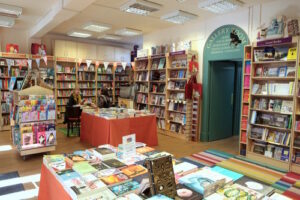
The Hunting Raven Bookstore
For many of our members at The Alliance of Independent Authors (ALLi), getting their self-published books into bookstores is part of their author dream. But how do you tell a bookstore about your work, what’s the best way to approach them, and what can you expect from selling in this way?
Why do authors want to sell in bookstores?
Many indie authors aren’t interested in trying to sell their books through bookstores, preferring to focus on an ebook model. This can be because of their audience preferences, the higher margins, or the simplicity of asset management on one platform and one format.
However, we also know that for a lot of our members, bookstore selling is part of their author plans, but may seem like a distant dream. And there are sound reasons for pursuing this path:
- Practical: certain books are much harder to sell in digital format, in particular children’s books, as younger readers still prefer to read print books. Similarly, if you are a non-fiction writer, with complex technical books full of diagrams, charts, photos, and other illustrations, they may not translate well into digital format.
- Emotional: for some, bookstores symbolise validation of your status as an author, reflecting a personal love of bookstores as cultural centers in our society. You may also have a loyalty to specific bookstores where you are a regular customer, or to the wider bookstore model, wanting to support the ongoing use of physical stores.
- Aspirational: for others, seeing your book on the shelf of a store may simply be a lifelong ambition, hard to shake off despite the book-retailing revolution that we’ve witnessed since the turn of the twenty-first century.
Whatever your reason, there is no shame in wanting to see your work in print on a bookstore shelf. Entering a store you are familiar with and finding your book amongst those on sale can be a fulfilling moment in an author’s life; worth the time and effort.
How difficult is it to sell your self-published books in bookstores?
Well, there is no doubt it can take time and effort to achieve bookstore distribution.
Bookstores are set up to discover, market and sell books to large audiences at often multiple locations. A central process for book purchasing, led by major publishers who can deliver a range of books from a range of authors all at once, is of course core to many bookstore models, particularly the chains.
They also have high targets to meet and large overheads for their premises, staff, and distribution networks, which means taking a chance on an indie book is a totally different prospect than on a digital platform. However, there are ways to achieve your goal, and we will share many of the tips here.
 Is it worth paying for full print distribution?
Is it worth paying for full print distribution?
If you are published by Ingram or Matador, authors do have the option for a full print distribution, with a team working on your book to mirror the process a traditional publisher will take. For example, your books would be featured alongside trade-published books, and sold by a dedicated and specialist in-house team directly into bookstores of all kinds.
It sounds attractive, right? But the economics of print-on demand publishing probably won’t allow for full-service distribution unless your book is in a high-pricing genre, you are established as a consistent bestseller, or ideally both. IngramSpark recommends that you need to have run up sales of about 50,000 books as the entry level to justify the cost of full-service distribution!
You’ll also need to be prepared to fit in with the conventional timing of the way trade-published books are sold to bookstores, i.e. up to six months in advance of a book’s publication date. There may also be other criteria to meet, such as being required to supply a large number of printed copies up front, so there is ready-made stock to sell.
It’s also worth noting that books actively “pushed” in this way, rather than ordered spontaneously by the bookstore based on their interest in it, are more likely to be returned unsold as part of most large chain’s ‘sale or return’ deal policies, which means that any books that do not sell after a set period of time can be returned to the supplier for full credit. And IngramSpark has commented that this is likely to be an average 60% return rate.
So what can an indie author do?
For most indie authors, the full print distribution route is not possible, at least not until they’ve hit that best-seller spot. So you will probably be looking at planning and running your own bookstore distribution yourself. And if you are happy that this may not result in high sales, but will achieve your goal of having your book in stores, it’s very doable, and we’ll show you how.
First, let’s recap on what sorts of bookstores are out there:
Chain bookstores
For chains, buying policy will be dictated centrally. But, even within a large chain, there will be some obvious local variations. In the UK, for example, a Waterstones in Glasgow will offer an abundance of books about Scotland, the highlands, or whisky and fishing. Whereas down on the south coast of England, sailing, bird-watching and wild swimming will be offered. The difference will come when the local team is selecting from what’s on offer centrally to suit their audience and ensure sales.
Independent bookstores
Independent booksellers, like indie authors, relish their freedom and independence. They’re often founded and staffed by people who have worked for the bookstore chains and are now going it alone. So they are highly experienced. They find it refreshing to no longer have to adhere to corporate guidelines dictated from remote head offices with shareholders to please, and will purchase their stock not centrally, but from a range of suppliers and routes.
Specialist bookstores
Specialist bookstores may cluster near relevant locations. Expect to find a medical bookstore on the campus of a medical school, or a legal bookstore near law courts and lawyers’ chambers. They’re worth seeking out if your book’s the right match and, as with the indies, will have staff who are passionate about high-quality books on their specialist subject.
Non-bookstore Specialist Outlets
Many other kinds of stores choose to sell a limited range of books as part of a much more diverse product range. While this might seem a more obvious opportunity for nonfiction books (history books in relevant museums, travel books in tourist offices, etc.), it can also work well for fiction. For example, US novelist Karen Myers’ Hounds of Annwn fantasy series, which features a strong foxhunting theme, is stocked in equestrian and hunting equipment shops. Similarly, historical novelist Anna Sayburn Lane has placed her debut novel, Unlawful Things – a thriller about the fictional quest for a lost play by Shakespeare’s contemporary Christopher Marlowe – in the busy gift shop of Shakespeare’s Globe Theatre in London.
Supermarkets and larger general stores
It’s now common for large superstores to have areas selling books. The sales here are focused on the proven best sellers and often cover just the top 100 sellers from that month. Buyers in this instance are not generally looking for any books outside of that small selection that their regular customers may pick up on a whim or when on sale.
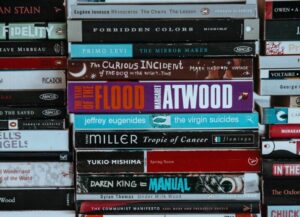
Photo by Annie Spratt on Unsplash
Which bookstores should I target with my self-published books?
For the time-pressed indie author, it may appear on the surface more efficient to focus on large chains where book-buying is centralized. However, you are then pitching yourself against a much bigger field of competition, including big publishers with a proven track record in sales.
Consider going local…
Instead, there’s a lot to be said for targeting those stores on your home territory. Being a local author adds an extra reason for the store to stock your book and can give you the edge as you can visit in person and even offer signings or join author events easily.
But don’t count out the chains. This local targeting can include chain branches of the big names in your area, particularly if you can see they have a table of local or unusual books, often found near the store entrance. Bear in mind, branches of chain shops will still need to buy from a central catalogue rather than direct from you, so your book will need to be available in this way. This can be done through IngramSpark, who has a page with further information about these options here. Be aware that you will need to select a wholesale discount to ensure you fit with the industry standard. ALLi suggests most authors choose the ‘no returns' option if you go this route, unless you have a specific reason not to and are prepared for the risks involved. This will ensure you won't get any nasty surprises if a lot of orders are placed, but a lot of returns are made too.
Targeting local indies, specialist bookstores, and non-bookstore specialist outlets should be part of your plan. Not only do they have more buying flexibility – meaning they can purchase direct from you rather than through central catalogues – but their locality and passion for books means you can also go in personally on a regular basis to top-up stock and build your relationship with the business owner. You'll find lots more tips about approaching these stores in this post.
Once you have conquered your local area, you can widen your reach further out. Remember that books store owners and staff often speak with one another too and you may find word of mouth picks up too.
So, first off, do your research and make a list of all the local stores you can approach, then widen out your reach as you tick off each one.
How do I warm up bookstores to my book?
KDP Print, IngramSpark, and Lightning Source offer wholesale distribution listing as standard, i.e. your books will be listed passively in their database. Further services, such as promotional catalogue entries, are available as an extra chargeable option. However, none of these routes actively promote your book with stores, and it will be listed alongside the many other self-published works out there, as well as the top best sellers and debut books with traditional publisher marketing efforts behind them. The chances of being found are low.
Publishers themselves will be targeting bookstores on behalf of their authors long before the store needs to place an order. This can take place six-months ahead of the book’s launch. Buyers will be seeing this active marketing at book fairs, in newsletters and mailings, on websites and catalogues, as well as through visiting sales reps. The publisher’s goal is to raise the profile of their client and their book so that it’s a no-brainer for the store or chain to order-in to fulfil potential reader demand.
As an indie author, you will need to wear your publisher’s hat to create your own plan to raise your profile amongst those you want to target.
Where can you place information about your book to raise your profile with buyers ahead of your approach?
- Trade publications: (Publishers Weekly in the US, The Bookseller in the UK) national press (The New York Times, US Today, The Times, The Guardian, etc). If you have an interesting story to tell about your book or your journey to authorhood, you may be able to target these, but it will be tricky against the big guns.
- Regional and local press: these are easier to place information in, particularly if your work has a local angle. But even if it doesn’t, a positive story of a resident achieving their writing dream can be of interest to local journalists as a ‘good news’ story.
- Reviews and endorsements from others: whether it's other authors (ideally with strong followings), book bloggers, or your own contacts sharing their reviews online, endorsements from others can catch a buyer's attention, so are never wasted energy. They can also be used in your pitch (see below) when you are ready to approach a bookstore direct.
- In person: building a relationship with bookstore staff can be extremely powerful, and if you have cards, bookmarks, or other small products with your details on to leave behind now and then as a reminder, this can raise your profile as a local author, ahead of your approach about your specific book or books.
How do I pitch my book to bookstores?
If you’ve got this far and you are still thinking bookstore sales are for you, the next step is to consider your pitch. You will need to ‘sell’ your book and yourself to a bookstore to convince them that your book offers them a good-quality and sellable product.
Here’s a step-by-step guide to help you walk through the process like you’ve been doing it all your life…
Choose your target
Start with the shop that makes you feel most confident of success: the one at which you are a regular customer, or the one whose clientele are the best match for your book. Once you’ve found success in one, you’ll have more confidence to approach another, so be kind to yourself and pick off the easiest target first.
Be your own mystery shopper
If you’re not already familiar with the bookstore, visit it beforehand, familiarize yourself with its layout, its opening hours, its website, its event program, and its typical customers. That way, you’ll be able to speak more knowledgeably and convincingly about why your book is a good fit for this particular store. Your research may even give you ideas for your meeting: for example, a proposal based on the success of a recent event held there.
Pinpoint the most appropriate staff member
Phone the store, check out its website, or ask at a preliminary visit for the name of the staff member who is responsible for buying in stock. That way, you can go straight to the person who has the most power to say yes to your proposition.
Make an appointment
Yes, you may get lucky and find that your target person is on the till if you pitch up at the store unannounced—but on the other hand, they will be there on duty to serve customers, and may not have the time to spare or the inclination to chat to authors unexpectedly.
Assemble your ammunition
It’s show and tell time! Along with a pristine copy of your book, pack up your AI (Advance Information) Sheet to provide an at-a-glance summary of all the key data about your book, plus any marketing collateral: copies of local media coverage, early reviews, and endorsements from respected authors in your field… Anything that will serve as objective proof of its worth as a saleable, profit-making resource in any bookstore. Can you also offer them a launch event or signing, and how would you market it and bring in customers to attend?
What do I put in my Advance Information Sheet about my self-published book?
An AI sheet provides an at-a-glance summary of the features of a new book, in a form that booksellers can easily absorb. It should be quick to read for a busy store owner (or reviewer), so limit yourself to one side of A4 only. It should include, at a minimum:
- Book cover image
- Book title and author name
- Brief overview of the book
- Brief author bio
- Some testimonials
- Technical data (ISBN, price, launch date, formats)
- Contact details in case of a query
You can find out more about AI sheets, including links to free templates, in the ALLi article: How to Create an AI Sheet.
Prepare answers to key questions
Think of all the questions a bookstore buyer might ask you, and have your Q&A ready-prepared in your head. Some questions to consider are:
- Why should the store stock your book?
- Where should your book sit on the shelves—which genre or specialism?
- Is there a local connection?
- Is there any recent or planned local or national PR that will alert people to look out for it?
- What online presence or social media following do you have?
- Will your author website promote this store as a stockist?
- Are you interested in holding an in-store event—and if so, would you bring your own audience?
- Do you have any other events planned and would you promote us as a stockist?
Act the part
No one can be as passionate about a book as its author, nor as knowledgeable, and you’re in a unique position to answer questions about it. But make sure you listen to your contact’s questions and respond to them, rather than treating the meeting as an opportunity to perform a soliloquy. Be polite, professional, pleasant, and respectful. Stand tall and put your shoulders back—it’ll relax you and make you feel and look more confident. Adopt a genuine smile, as if you’re pleased to be there and to meet your contact (well, you are, aren’t you?). Be ready to shake hands, or exchange bows, or whatever other gesture is the body language of the business-like in your country. Remember that the impression you make on the first meeting will also be taken as an indicator of how well you’d perform at an in-store event.
What next?
The buyer said yes…
If the buyer says yes, fantastic! Make sure you then go on to fulfil the agreed obligations, delivering the agreed number of books (if they’re buying direct from you rather than from a distributor), promptly collecting unsold copies if you’ve agreed on sale or return, and submitting paperwork efficiently as required. Then move on to target your next most likely store. Don’t expect your buyer to take a whole case of your books straight away. Most buyers will test the water with a small number of copies—think low single figures—and come back for more if those sell. So don’t be disappointed. Try to hasten those first sales by promoting the store as a new stockist, via your website, social media, etc.
The buyer wanted some time…
If the buyer doesn’t make an immediate decision, accept that they need more time and ask what the next step should be—should you phone, email, or visit at a certain time? Or leave it to them to contact you? Don’t apply pressure or be ungracious. At least they haven’t given you an outright no, and that’s a good thing! Any reasons for hesitating are likely to be sound and considered. They may need to consult colleagues, consider how it might fit in with other books, or even to take the time to read the book themselves.
The buyer said no…
Accept defeat graciously. Try to assess whether there was anything you did wrong, or whether it’s simply the case that the book isn’t a good fit for the store. Once you’ve gleaned anything there is to learn from the experience, move on. There are plenty more bookstores out there, and at least now you have a ready-made contact for when you’re ready to go in and pitch your next book. Whatever you do, don’t take rejection personally. Remember, there are so many books out there vying for the same shelf space as you in that store, and only a tiny percentage can physically fit.
Bookstore events for self-published authors
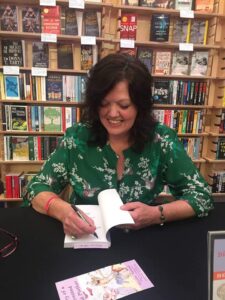
Nicola Kelsall signs books in the Festival Bookstore
Holding an in-store launch is a great way to celebrate the birth of your book and can be a strong selling point for the store for taking on your work. However, do not expect the bookstore staff to run it for you. You will need to treat it as your own party, at your own expense, providing the refreshments, decorations, advance publicity, and invitations to ensure you have plenty of guests show up.
To help raise your credibility and build your long-term relationship with the store staff, do all you can to bring in everyone you know. Even better, see if you can persuade them all to buy books on the night, via the store, especially if you know they’re likely to buy them anyway.
What should you expect from a bookstore event?
But don’t expect to recover your costs in profits from your book sales. Raising your profile will be the biggest benefit of an event; from sharing advance publicity on your website, in the local media, coverage on social media, and post-event news stories. You may find it leads to other event opportunities, such as signings at other stores or talks at local libraries or special interest shops.
Some bookstores prefer to run events outside of their normal opening hours. In stores that have very little room to move, they may even prefer to host events at a different venue away from the shop, though endorsing it from the shop and promoting it as their event. Don’t be offended if they suggest either of these alternatives; just graciously accept what you’re offered and make the best of it.
Bookstores often like to tie in with national and international events: anniversaries or centenaries or national bookseller-driven campaigns, e.g. in the US, the annual Independent Bookstore Day; in Australia, National Bookstore Day; in Canada, Authors for Indies Day; and in the UK, Independent Booksellers’ Week, or World Book Day and World Book Night. For all of these events, bookstores will welcome suggestions.
Consider linking up with other authors to run an event together. This adds more bulk to the audience and offers a range of books for people to pick from. Three minutes is the standard length allowed for readings at a poetry slam and some use this as a rule for group launches too. The time should cover: your “elevator pitch”, a witty or catchy intro, and a two and a half minute reading. Finish with a “thanks everyone” and wave your book as you leave in triumph.

Ben Galley, Author
Author case study – Ben Galley – taking a self-published book into a bookstore
Ben Galley is a best-selling author of tall tales and dark fantasy from the UK. He is the author behind the gritty and epic Emaneska Series, as well as his new western fantasy series, the Scarlet Star Trilogy.
Ben shared his experience with ALLi a little while ago, talking through a great example of how he took his book from ebook to the shelves of Waterstones:
“You can't just waltz in there and ask them to put your book on the shelf!” came the cries. But to me, it made perfect sense. Why? Waterstones actively employees people that are avid readers and book lovers.
The passion is obvious in every store I’ve visited. As self-publishers, this fact gives us an IN. A rapport. A common ground. My then local branch – Guildford Waterstones – is one such store. By the time I had finished The Written, a few of the staff were good friends. My book eventually came up in conversation, and being big fantasy readers, they were genuinely interested in reading it.
Making the bookstore pitch
So, when I finally brought in a copy to show them, looking smart and respectable for once too, I was bold enough to suggest stocking it as a test run. There was no formal request, just a friendly question. Impressed by its cover, they agreed, and eight copies were ordered there and then.
Was that luck? A friendly favour? No. My success was due to the freedom that Waterstones branches are given by head office. Despite having a big-chain structure, they understand that local interest is a big sales factor, and thus allow their managers the freedom to take small risks on previously unknown books, provided they are profitable. And accessible.
I was local. I had ISBNs and barcodes (Note: both are essential for selling in bookstores). The booksellers liked my book. Thanks to my POD company, I was available through Gardeners, their wholesalers. Before I knew it, my book was suddenly on Waterstone's shelves.
I made sure the eight copies sold out within the first two days. Impressed, the Guildford branch then ordered some more. My books have been a permanent feature of their shelves ever since.
Leveraging success
I used the leverage of the initial success to book two signings at another local branch and the Guildford store. I managed to sell a decent number of books at the first, and combining social media and local press, I managed to completely sell out at Guildford, making them around £200 for their trouble. Not only that, I drummed up exposure for them, too.
Using my small, yet proven track record, I was able to pick up the phone and get my books stocked across branches in Surrey and in a few large branches in Hampshire. I could give them numbers and details that made my book sound lucrative. I offered to do signings, and when I did them, I made sure I sold out by using my marketing skills and local power. If you can sell out every time and make them money, they will be more than happy to stock you for the rest of your career. All self-publishing misconceptions, if any, will be forgotten.
Word-of-mouth expansion
In big chains, like Waterstones, there is a huge amount of communication between branches. Most of my signings have come from word-of-mouth or via emails of recommendation from store and area managers. In this way, spreading across a big-chain estate is a viral approach. Start where you are most powerful and then expand.
As I reached each new bookshop, I made sure I left an impression. I asked if they would be stocking my books from then on, left marketing materials like flyers and free badges, and kept in touch. Thanks to that approach, I’m often asked to come back, have made some great friends, and now regularly receive emails beginning with: “We heard you did very well at X branch, and were wondering if you’d like to come to ours…”
In Conclusion
If getting your self-published books into bookstores is part of your author dream, it’s not out of reach.
By setting a plan, focusing on local and specialist stores, and putting in the hard work, you have a great chance of seeing your work in print alongside the bestsellers.
Find out more
Some of the information in this post has been edited from our popular Get your Self-Published Books into Bookstores publication.
This book, is available for purchase in multiple formats on our bookstore. Members enjoy free access to the ebook as one of the many advantages of ALLi membership.

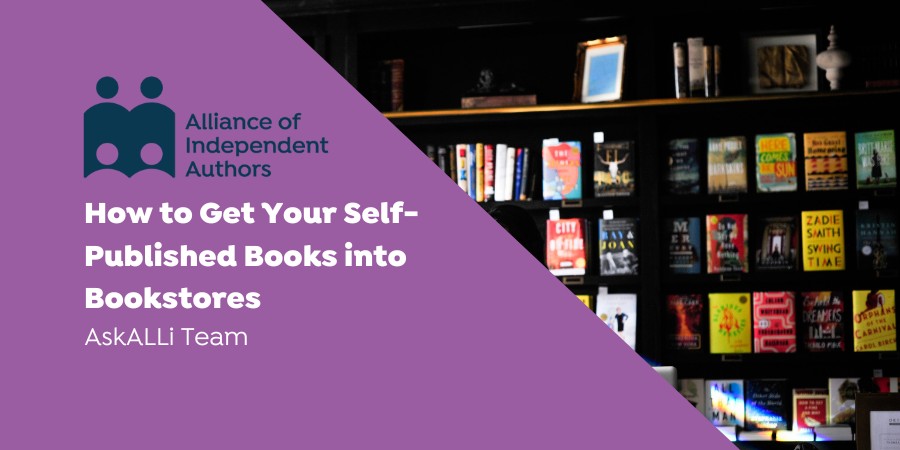
 Is it worth paying for full print distribution?
Is it worth paying for full print distribution?
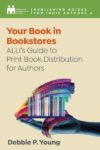



Hello,
Thank you, I found this article useful. However the problem I find is bookshops in the UK don’t deal with IngramSpark. They want your book to be listed with Gardners and Gardners won’t list print-on-demand books by relatively unknown authors. Do you have any suggestions please on how one can be listed with Gardners?
Thanks.
Leona
Ingram sets up your book on Gardners Leona. There was a mismatch a while ago but our understanding is that is resolved